Spider Diagram
Display up to nine levels of decomposition of entities using Innoslate's Spider Diagrams.
Using Spider Diagrams
| Function | Description |
|---|---|
| Creating Spider Diagrams | Using ‘Diagrams View’ in Innoslate, you can create a new ‘Spider Diagram.’ |
| Viewing Spider Diagrams | You can ‘View a Spider Diagram’ of any new or existing entity of any class via the ‘Open’ drop-down menu, where available. |
| Adding an Entity | An entity can be added to a ‘Spider Diagram’ via drag-and-drop. |
| Removing an Entity | An entity can be easily removed from a ‘Spider Diagram’. |
| Modifying Relationship Attributes | The Relationships attributes can easily be modified in the ‘Spider Diagram’. |
| Spider Diagram Settings | Overview of the Spider Diagram Settings Menu |
The ‘Spider Diagram’ is a type of hierarchical organizational chart used in Innoslate as a means of visualizing traceability. This diagram is capable of displaying up to nine levels of decomposition of entities arranged in concentric circles radiating outwards from the center and conforms to the LML Specification 1.4 definition of a ‘Spider Diagram,’ which requires visualization for traceability beyond what a typical hierarchy-type diagram can offer.
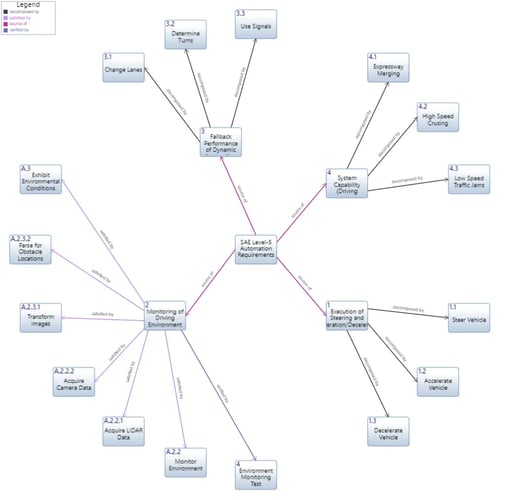
The ‘Spider Diagram’ is not composed of special diagram constructs. In fact, a ‘Spider Diagram’ can be generated by Innoslate on the fly based on the current contents of your project’s database. The ‘Spider Diagram’ is built using entities in the database of any class and any of their relationships. The entities display as rounded blocks containing the number and name of the entity, and their relationships create the structure displayed as arrow lines.
Creating Spider Diagrams
Within the ‘Diagrams Dashboard,’ users can create a new diagram by clicking the ‘ New Diagram’ button in the top right corner of the page.

Clicking the ‘ New Diagram’ button will open the New Diagram dialog where you will be directed through the process of creating a new diagram.
For the below example, we will be using the Action class. Please note, you may use any entity class to start a Spider Diagram.
Create a Spider Diagram
- Choose Which Type of Diagram to Create
In step 1, select ‘Spider Diagram,’ under ‘LML,’ as your diagram type.

Select which class of entity to use as the root entity.

Click the ‘Next’ button.

- Specify New Root Action Information
In step 2, you will be prompted to input a diagram ‘Name,’ ‘Number’ (optional), and ‘Description’ (optional). Then, click the ‘Finish’ button to save to open your new Spider Diagram.
Viewing Spider Diagrams
In Innoslate, you can view a ‘Spider Diagram’ from wherever the ‘Open’ drop-down menu is available on the toolbar (Entity View, Database View, within a Document, within a Diagram, within a Test Suite).
View a Spider Diagram
- Locate and click the ‘Open’ drop-down menu in the toolbar. Select ‘Spider Diagram.’

- This will navigate you to view a ‘Spider Diagram,’ where you can begin adding and removing entities. Click the ‘Save’ button located on the toolbar to persist your changes to your project’s database.

Left Sidebar of Spider Diagram

When in a Spider Diagram, note the left sidebar shown above,and the options provided under the New Tab. This is important to note because of the full traceability the Diagram can provide and its ability to show any entity class and any of their relationships. There are many options users can choose from here, so below we will cover these options. The red box indicates the Entity Class options and the blue box indicates the relationship options available.
As indicated with the red box above, this is a dropdown for users to indicate the class of the construct the user will use when adding it to the Diagram canvas. Notice the scroll bar on the right, as this dropdown is a full list of all the entity classes available in the project.
The dropdowns in the blue box provides the options of the relationship choices available. There are 2 dropdowns here, the first dropdown are preselected relationships for user's convenience labeled as 'Select Presets.' Two options in this dropdown are provided by default. The second option 'All Relationships' allows users to show on the diagram canvas all relationships set for the root entity.

When All Relationships are chosen, the left sidebar will update and provide the option to generate all relationships made to the entity. This option is particularly helpful for already existing entities that have relationships established, not a diagram started from scratch.


The 'Traceability Relationships' option in the Preset dropdown, are preset to show the main traceability relationships as indicated in the Lifecycle Modeling Language. The relationships for this preset option is shown above. Note, that users may select more relationship types with the second dropdown to include more relationships, as shown below. Users may then generate these relationships to appear on the canvas with the blue 'Generate' button.

As indicated with the black box above, this save option appears when users create a new grouping of relationships and provides a way for users to save the group of relationships as a preset. When this option is selected, a pop up will appear so users may give the new group of relationships a preset name for users to recall in the Preset Dropdown on the left sidebar.

Note when users select a user created preset, an option to remove the preset from this list will also appear on the left sidebar, as indicated below in the black box.


The Remove Preset window appears for users to select what preset to delete. Use the selector boxes on the right to select what preset(s) to 'Remove'.
Adding an Entity
An entity can be added to a ‘Spider Diagram’ via drag-and-drop.
For the below example, we will be using the Action class. Please note, you may use any entity class to start a Spider Diagram.
- Within a ‘Spider Diagram,’ ensure you do not currently have a block selected, and click the ‘Action’ icon in the ‘New’ tab of the left sidebar and continue to hold down the left mouse button.

- Drag the ‘Action’ icon over to the adjacent diagram canvas.

- Release the left mouse button while over the diagram canvas to drop the new ‘Action’ and add it to the diagram.

Notice the ‘Action’ stays selected once it has been dropped. Since it is selected, the toolbar changes to include buttons for functions that can be used on the construct. The sidebar also changes to show the ‘Metadata,’ ‘Attributes’ and ‘Relationships’ tabs.
- Enter a meaningful ‘Name’ for your new ‘Action’ via the ‘Attributes’ tab of the left sidebar (focused automatically for convenience).

- With the new ‘Action’ still selected, add a relationship to another entity by clicking one of the green circles and continuing to hold down the left mouse button.

- Drag the green circle to another entity block of your choice that you would like to create a relationship with.

- When the other entity block highlights bright green, release the left mouse button to add a relationship.

- This opens the ‘Create New Relationship’ dialog. Use the drop-down menu or type in the name of the relationship you would like to add in the ‘Select option’ field.

- Finally, click on the ‘Create’ button.
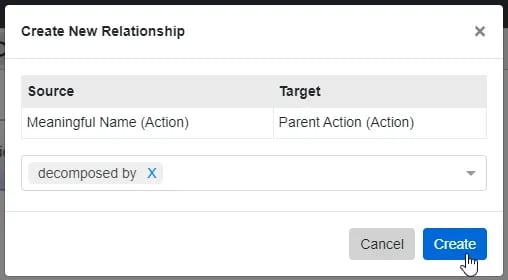
- The relationship of your choice will be added to the appropriate two entities.

- Click the ‘Save’ button located on the toolbar to persist your changes to your project’s database.

* Note: The above process describes using the ‘New’ tab of the left sidebar, which automatically generates a new entity to represent each new block. If you would like to reuse existing entities from your database in your diagram, use the ‘Existing’ tab instead.
Modifying a Construct on the Spider Diagram
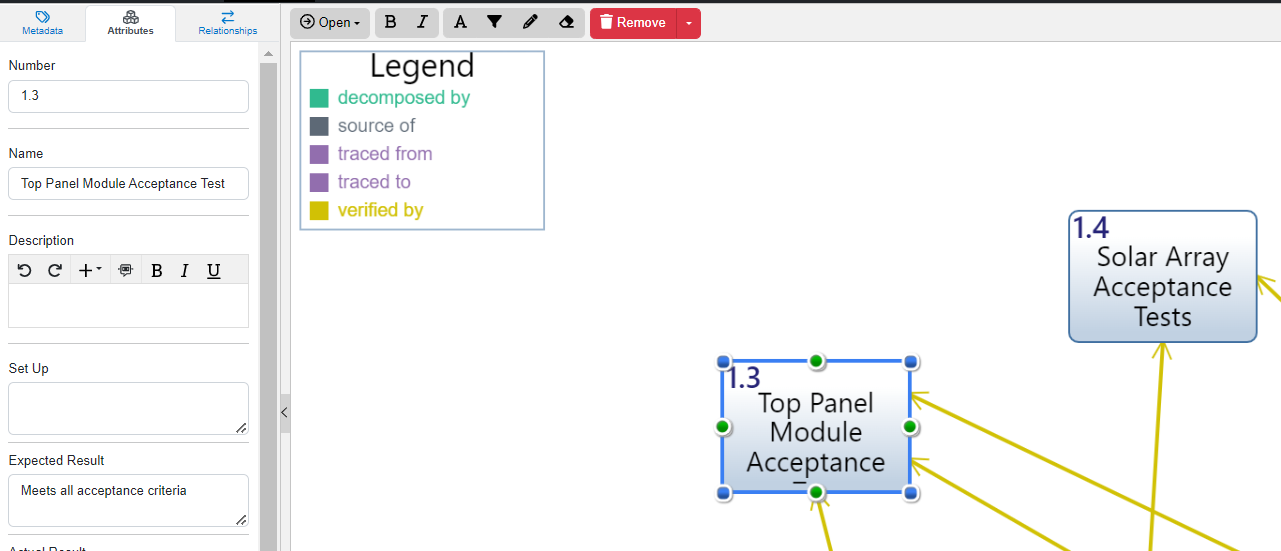
When an entity is selected, there are options available on the top toolbar frame to modify the entity, as shown below.

Below we will go over these options.
 The Open dropdown will open up the selected entity into other views. For more clarification on the Open dropdown please see here.
The Open dropdown will open up the selected entity into other views. For more clarification on the Open dropdown please see here.
 This button will 'Bold' the name for the construct in the construct on the canvas.
This button will 'Bold' the name for the construct in the construct on the canvas.
 This button will 'Italicize' the name for the entity in the construct on the canvas.
This button will 'Italicize' the name for the entity in the construct on the canvas.
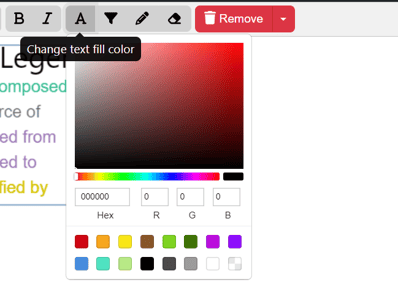
Using the HTML Color Picker that drops down from the 'Change Text Fill Color Option', users can change the text color of the Asset's name in the construct on the canvas by selecting the color associated close to the desired color and selecting from the color canvas in the dropdown or simply inputting in the fields the proper codes and numbers.
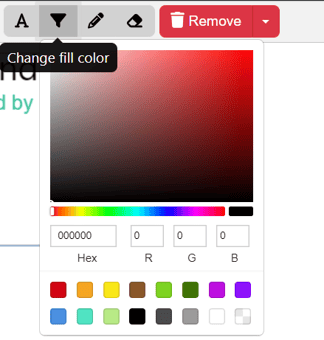
To change the color of the construct of the entity's construct on the Canvas, the 'Change Fill Color' option can be used with the HTML Color Picker dropdown, by selecting the color associated close to the desired color and selecting fromt he color canvas in the dropdown or simply inputting in the fields the proper codes and numbers.
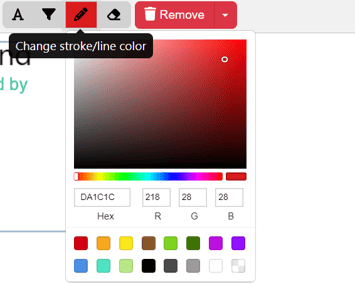
The Change stroke/line color option will change the color of the line bordering the entity.

The 'Reset color back to default' option will reset the construct fill, border and text color back to gray and black.
Removing an Entity
An entity can be easily removed from a ‘Spider Diagram.’
- Within a ‘Spider Diagram,’ select the entity you wish to remove. This will make the toolbar appear with applicable functions which can be used on the selected entity.

- Click the ‘Remove’ button to remove the entity from the diagram (as the default action).

*Note: The ‘Remove’ button also includes a drop-down menu where you can select ‘Delete from Database’ or the default option of ‘Remove from Diagram.’
Line Construct Labels
Note that users also may drag the label of the line construct on the canvas, by selecting the name and dragging it. Upon doing so, a line will appear to indicate the Line construct label's name, as indicated in the red circle below.

Modifying Line Constructs

When a line construct is selected, as indicated by the blue line above, the options on the top toolbar frame change. As shown below, we will cover these options for users to modify.

 This will 'Bold' the label for the relationship name on the line on the canvas.
This will 'Bold' the label for the relationship name on the line on the canvas.
 This will 'Italicize' the label for the relationship name on the line on the canvas.
This will 'Italicize' the label for the relationship name on the line on the canvas.

Using the HTML Color Picker that drops down from the 'Change Text Fill Color Option', users can change the text color of the label to the conduit the canvas by selecting the color associated close to the desired color and selecting from the color canvas in the dropdown or simply inputting in the fields the proper codes and numbers.

To change the color of the border of the entity, the 'Change Stroke/line color option' can be used with the HTML Color Picker dropdown, by selecting the color associated close to the desired color and selecting from the color canvas in the dropdown or simply inputting in the fields the proper codes and numbers.

The 'Reset color back to default' option will bring the color of the Conduit's line and text colors back to black.

Users may also change the line type from straight to orthogonal, hide or show the label (relationship)n or be Reset.
Modifying Relationship Attributes
The Relationships attributes can easily be modified in the ‘Spider Diagram’.
- Click an edge that has a relationship attribute.

- Click the Attribute button.

- Edit the desired relationship attribute in the modal.
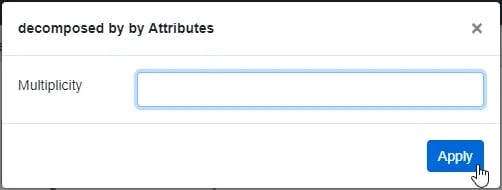
- Click done to finish or the X to cancel to go back to the Spider Diagram.
Multiple Entities Selected

Users may drag their cursor outside of the constructs and a box will appear to select as many multiple entites the user desires. Many features on the top toolbar will appear upon doing so for the user to utilize. Let's go over each option as highlighted below.

 This option will 'Bold' all the names of the multiple entities selected on the canvas.
This option will 'Bold' all the names of the multiple entities selected on the canvas.
 This option will 'Italicize' all the names of the multiple entities selected on the canvas.
This option will 'Italicize' all the names of the multiple entities selected on the canvas.
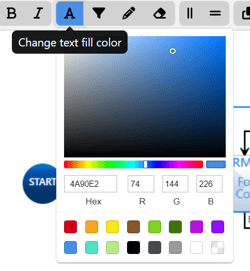
Using the HTML Color Picker that drops down from the Text Fill Color Option, users can change the text color of the multiple entities selected on the canvas by selecting the color associated close to the desired color simply inputting in the fields the proper codes and numbers.

Using the HTML Color Picker that drops down from the Text Fill Color Option, users can change the color of the constructs of the multiple entities selected on the canvas.

Using the HTML Color Picker that drops down from the Change Line/Stroke Color Option, users can change the color that borders the constructs of the multiple entities selected on the canvas.

The Reset color back to default option will change the multiple entities selected on the canvas back to the default gray and black colors.
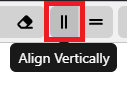
This selection will align the constructs vertically for the multiple entities selected on the canvas.
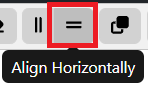
This selection will align the constructs horizontally for the multiple entities selected on the canvas.

The Clone Shape option is to bring size uniformity to the diagram's constructs. When this option is selected, the green highlighted entity will be what the other constructs clone to so they are all the same size.
Spider Diagram Settings
The Wrench icon, located at the top right of the toolbar frame, is a fixed button that opens up a Settings menu. These options are specifically tailored for the Spider Diagram.

The first category is to indicate how many levels of traceability the user would like to display in the Diagram, levels 1-10.

The Edit Colors option allows users to modify the color legend and assign colors to the relationships shown. A window appears as shown below for modification. The pencil icon will have the HTML color picker appear for users to choose the new color. The eraser to the right of the pencil option will reset the color back to the defaulted color.

Users may also use the Reset button on the bottom left of this window to allow Innoslate to reset back to the defaulted colors that are not originally part of the Color Schema.

Users may also show or hide cross-project indicators, the legend and colors. Note, when hiding the colors, all the lines and relationship labels will turn black.
 The Reassign colors option will reassign the colors of the specific lines users have changed the colors to back to the original color schema.
The Reassign colors option will reassign the colors of the specific lines users have changed the colors to back to the original color schema.

Users may also Auto Number their diagram, where a pop up shows up to allow users to use the action order to determine the number sequence, provide a Prefix or enumerate the single level, as shown below.


The final options provide users to reset their diagram, layout the diagram and go directly to the Help Center page for the Spider Diagram for convenience.
Tutorial Video

